The Gift of South Dakota
Subscriptions to South Dakota Magazine make great gifts!
Subscribe today — 1 year (6 issues) is just $29!
Desert or Not?
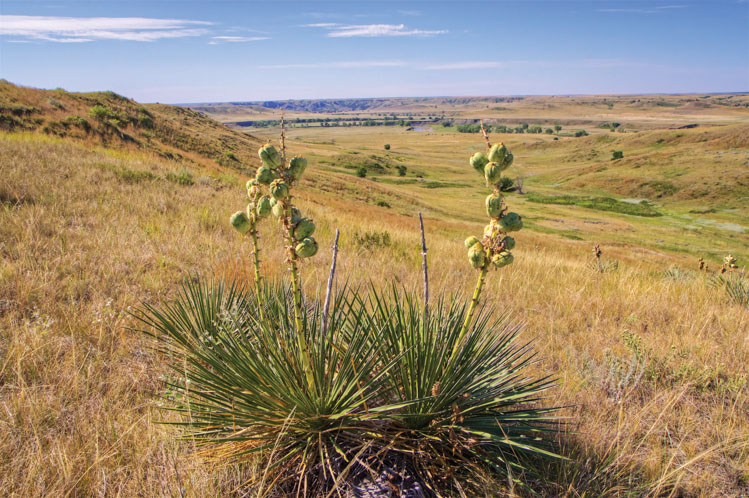 |
| The flora of western South Dakota, which includes cactus, yucca and deep-rooted native grasses, reflect the region's semi-arid climate. |
FAMOUS EXPLORERS and scientists labeled a big portion of the Northern Prairie a desert in the 19th century, including all of South Dakota’s modern day West River country.
The description took hold for more than a century because desert is one of those words in the English language that has a mysterious and ominous aura, especially to any brave man or woman who owns cattle — or, even more disconcerting, a corn planter — in western South Dakota.
Zebulon Pike, the namesake of Colorado’s Pike’s Peak, was among the first to use the “D” word. Pike made several expeditions in the early 19th century, and though he probably never reached the borders of today’s South Dakota, he compared lands west of here to the African deserts.
Thomas Nuttall, an English naturalist, traveled up the Missouri River valley in 1819 and collected samples of the prairie cactus and yucca plants that still thrive today. Perhaps he encountered a stretch of hot and dry weather, but for whatever reason he also described it as an inhospitable desert.
A few years later, the highly regarded explorer Stephen Long — who was born in New Hampshire and educated as an engineer at Dartmouth — came to the region and famously proclaimed it, “The Great American Desert.” It’s unlikely that Long also never set foot in the borders of South Dakota. Most of his explorations followed the Platte River in Nebraska, but his blanket assessment was considered geographic gospel for decades.
Even in the 1890s, a generation after the Homestead Act of 1862 encouraged western settlement, scientists were warning that the plains climate could be incompatible with East Coast expectations. John Wesley Powell, a geologist who mapped the plains states and was often called the dean of the American West, bravely bucked the pro-development optimists and warned that land west of the 100th meridian, which divides South Dakota east and west, was too arid to farm.
However, politicians and railroad officials promised that the western plains were not a desert but an untapped Garden of Eden that only needed cultivation. “Rains follows the plow,” promised Illinois entomologist Cyrus Thomas. Rain might even condense from the steam of the locomotives, boasted one railroader. Land-hungry pioneers became believers.
Edith Ammons Kohl was one of those hopeful homesteaders. She settled in Lyman County, and later wrote about the experience in her book, Land of the Burnt Thigh, in which she tells of a well-dressed land agent who came from Pierre to see if she was ready to sell her land. She offered him a drink of dirty well water from a can she kept in the shade of the shack, but the agent couldn’t stand to drink it.
He looked at the glazing sky, the baked earth, a snake slithering from the path back into the dry grass which rustled as it moved.
“So this is the land you want to save,” he exclaimed. “The incredible thing is that people have managed to stay on it at all.”
“They will stay,” I assured him.
*****
EDITH AMMONS KOHL was correct. Stay they have. It’s common to meet fourth, fifth and sixth generation ranchers, surviving on lands where yucca and cacti still grow, and where snakes still crawl — the very land that was once labeled a desert by educated and worldly travelers. We traveled to Butte County, one of the driest places in South Dakota, to meet some of the survivors.
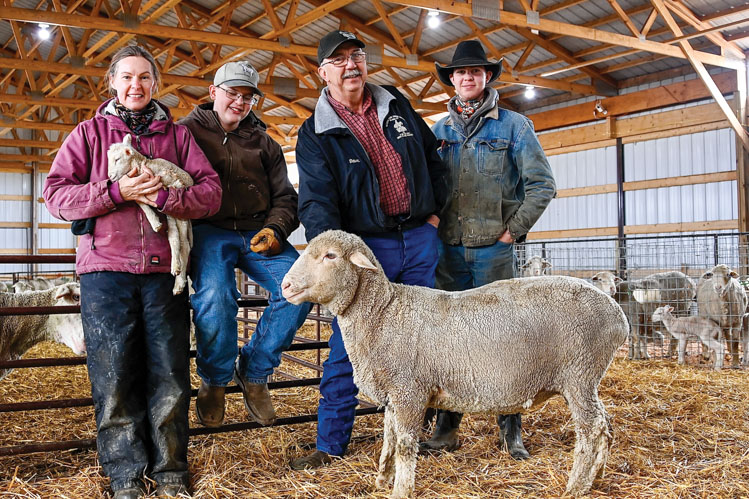 |
| David and Holly Ollila and their sons, Tate (far right) and Finn (seated on fence) raise sheep and cattle on their Butte County ranch. "Sheep are a desert animal," David Ollila says. "They'll do fine on what the cattle won't even touch." |
David Ollila’s great-grandfather immigrated from Finland to work at Homestake Gold Mine, and then homesteaded in Butte County in 1916. He died of miner’s lung in 1936, leaving his son (David’s grandfather) to run the ranch.
Ollila (pronounced O-la-la) is a lanky, soft-spoken South Dakotan who has the appearance of someone Big Tobacco might have once recruited for their cigarette commercials, though he’s not a smoker. He and his wife, Holly, have three sons. Ethan works as an electrical lineman in Wyoming. His parents believe it’s likely that he’ll someday return to the ranch. Finn, 11, and Tate, 17, are still at home and actively involved in raising sheep and cattle.
Butte County enjoys 13 or 14 inches of moisture from snow and rain in an average year. During droughts, the moisture often dips below the 10-inch threshold that soil scientists now use to separate arid (desert) lands from semi-arid regions.
“Stephen Long was not wrong [to call the land a desert], considering where he came from and what he knew,” Ollila says. “Neither was Frank Popper, who called this country the Buffalo Commons and declared it wasn’t fit for farming. If you take Midwest farm practices and try to do them here, then it’s not sustainable. Take away crop insurance and you’d fail in a hurry.”
Ollila, who taught agriculture at the Lemmon and Newell high schools for 25 years, says most of the people who survive today have learned to temper their expectations, lifestyle and practices with the land.
“They often say that the only ones who make money are the ones who sell out before they are broke,” Ollila jests. However, his wry country wisdom has a ring of truth. Regardless of the desert connotation (and maybe in part because of its wilderness mystique), land prices have far outgrown any reasonable assessment on what an acre of ground might be worth as an investment. The surest path to success for most ranchers would be to sell their land and cattle.
The land was free to homesteaders who promised to plow a few fields, plant trees and build a shack. A generation later, during the Dust Bowl of the 1930s, the land could hardly be given away. Ollila remembers it selling for $25 an acre as recently as the 1980s, which was another difficult era for agriculture.
“Now the same land brings $800 an acre,” he says. “Think of that. Try to factor $800 an acre into how much a cow can return.”
*****
OLLILA SAYS HE and many of his neighbors are looking to the past, trying to learn from both the mistakes and the successes of their predecessors. He says the buffalo culture that predated the arrival of homesteaders is a centuries-old example of what today’s ranchers call rotational grazing. Buffalo herds constantly migrated across the short-grass prairie, moving on quickly before they damaged the roots of the all-important native grasses. Deer, elk and pronghorns followed them, grazing on shrubs and weeds that the buffalo wouldn’t eat.
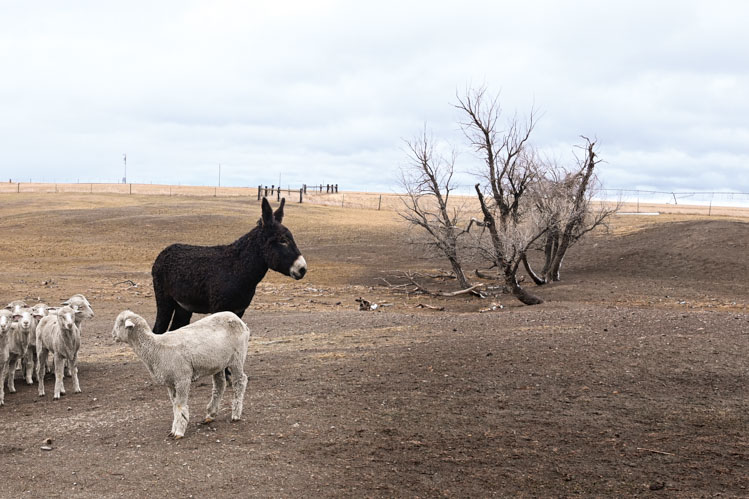 |
| Sassafras is one of three donkeys that protect sheep from predators on the Ollila ranch. |
Today, conservation-minded ranchers do the same — rotating cattle from one pasture to another, then following with sheep or goats. “Sheep are a desert animal,” Ollila says. “They’ll do fine on what the cattle won’t even touch.”
Every generation of ranchers has learned new tricks. “Our grandfathers developed the idea of cover crops, and now today that’s a huge part of good management of cropland,” Ollila says.
Ranchers have also developed the concept of “flushing,” a practice of feeding ewes a rich diet during breeding season to boost the number of multiple births. Just like deer and elk in the wild, domestic sheep are much more likely to have twins and triplets when nature is signaling that the food supply is good.
“We’ve moved our lamb crop from 120 percent to 180 percent, and we’ve even hit 200 percent, by pasturing them on cover crops,” Ollila says. Most ewes can manage to nurse twins, but when triplets are born the Ollilas usually remove one of the lambs from the mother and bottle feed it in a big pen of “orphans,” though that’s a misnomer because the Ollila orphan lambs are very pampered. Finn even gives them each a name.
Sharing such ideas and best practices is the mission of two new organizations, The South Dakota Soil Health Coalition and the South Dakota Grasslands Coalition. Ollila, who is active in both, says they are landowner groups that cooperate with other organizations, such as the U.S. Forest Service, the Bureau of Land Management, Nature Conservancy, the Audubon Society and anyone who has an interest in the land.
“What we’re doing is encouraging people in ranching and farming to maximize their natural environments,” he says. “Part of this is just lessening the expectations and figuring out how to work with the land and what it will provide — not trying to make it produce more than it can.”
That’s in stark contrast to much of the agri-business world, where chemicals and fertilizers are used to chase bigger and bigger yields. “Sadly, some folks pay too much for the land and then they have to expect too much out of it, even in more fertile parts of the country,” Ollila says.
*****
WE LEFT THE OLLILA RANCH, crossed Dry Creek, and drove west on Highway 212 to Belle Fourche, the biggest city (pop. 5,600) in Butte County and a place that clearly exists to serve farm and ranch families. The most visible business enterprises involve tractors, fencing, livestock services, irrigation equipment and wool.
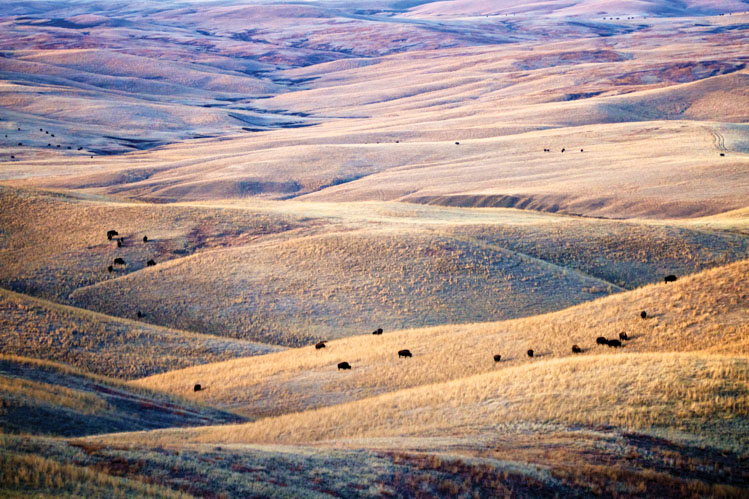 |
| Hills along the Bad River valley near Wendte are subtle reminders of when the region was an ancient desert of sand dunes. Today, the soils are rooted in place by a dense but fragile ecosystem of native grasses. |
Belle Fourche has bragging rights as the Center of the Nation. The geographic middle of the continental U.S. is just a short drive north of town. It’s also known as the convergence of the Redwater and Belle Fourche rivers.
Yes, there’s water in this arid country. Just a few miles east of town lies an 8,000-acre lake known as the Belle Fourche Reservoir, which was created in 1911 by a mile-long dam on Owl Creek.
Tucked into a small house near the junction of the two rivers is the town’s Green Bean Coffee House. That’s where we met Mary Clarkson Buchholz, whose family ranches northwest of town near the Montana border. Mary also serves on the board of Pioneer Bank, which is just west of the coffee shop, and she writes a history column for the town’s weekly newspaper, the Belle Fourche Beacon.
She says the drought-stricken 1930s were a defining era. “My dad always said that before that, there was one homesteader on every quarter section [160 acres] and now it takes 40 acres for one cow-calf pair, maybe twice that much in dry years. When it got tough, some left, and others dug in.”
Ed Goss, a friend of the Buchholz family and a retired manager of the town’s big wool cooperative, was born and raised 350 miles east of Belle Fourche in Kingsbury County, where the average rainfall is double that of Butte County.
He says he learned at an early age that the very concept of drought and deserts is relative. He recalls that farmers on the west side of Kingsbury County always lamented that they got less rain than their counterparts on the east side, just 20 miles away.
Mary Buchholz says the same is true in Butte County, where there are grain fields on the east side, thanks in part to the irrigation systems, and nothing but cattle and sheep on the drier western side.
It must be human nature to look for dividing lines. Goss says there is such a line between the arid west and the eastern croplands — the invisible 100th meridian, a longitudinal line that divides South Dakota in half.
“Go look by the town of Blunt, east of Pierre,” Goss advised us. “There’s an historical marker there that says the bankers shouldn’t loan money for farming west of that point, on the 100th meridian, because it’s just too darn dry for anything to grow beyond that point.”
*****
AS DRY AS IT GETS in West River, two of its best-known wordsmiths say they don’t often hear their rural neighbors use the word desert.
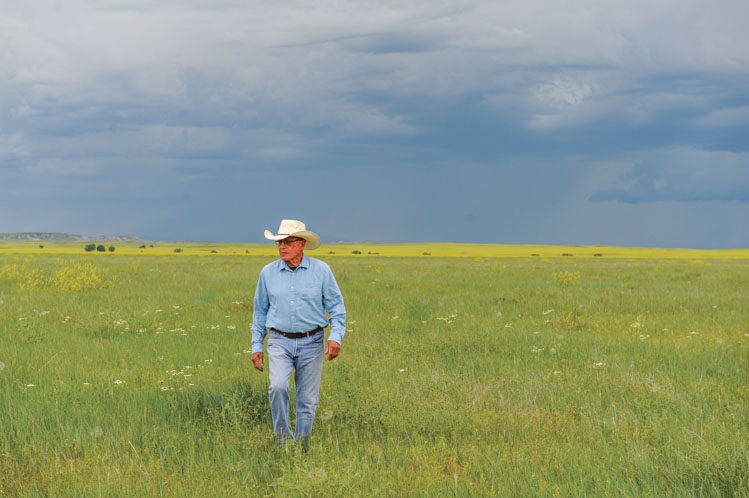 |
| Rancher and author Dan O'Brien practices "regenerative agriculture" on his family's Wild Idea Buffalo Ranch. |
“I’ve never heard that term applied to the landscape here,” says Linda Hasselstrom, a writer and ranch owner at Hermosa. “My father used to joke that where our land over east of the ranch broke into the Badlands that it was desert, but that was a very small portion of what we owned.”
Regardless of terminology, Hasselstrom says West River is a challenging environment that requires a close relationship with Mother Nature. “One of the best conversations I ever had with my father was when I was about 12 and we were haying,” she says. “We were lying down after lunch, under the trees in the field. He said he wondered if trees were really conscious beings and aware of us, only living at a slower tempo than ours so we never grasp their consciousness. I’ve never looked at a tree the same way since.”
Dan O’Brien, a buffalo rancher and writer, agrees with Hasselstrom. “I don’t look at this place as a desert, even though there are some similarities.” He pictures a desert as a barren land of blowing sand, “while our prairie is a diverse ecosystem of grasses that have evolved not only to survive but to thrive.”
O’Brien’s book, Buffalo for the Broken Heart, is a parallel story of how his own life has become woven with the natural world, particularly the native grasses and buffalo.
He borrowed money to buy a small ranch southeast of Rapid City in the 1990s because he was attracted to the wildness of the region, but he soon discovered that neither his heart nor his pocketbook found satisfaction in raising cattle, the traditional hard-luck method of making a living on grass.
O’Brien switched to buffalo, and soon realized that the wild beasts were a better fit for both him and the land. Today, he and his family run Wild Idea Buffalo Company, a ranch devoted to what he terms “regenerative agriculture.” Their goal is to have a positive impact on both the arid landscape and the food supply. The experience has given him both hope and worry for the future.
“This landscape has been politically charged from the very beginning,” he says. “The railroads were out to get people here and they promoted it as a Garden of Eden. Of course, there were a lot of disappointed people. There are seven old homesteads on our land alone. Every now and then, I’ll see an old cast iron stove that was left behind or some lilacs still blooming that were planted long ago by some woman who was trying so hard, and I’ll think, ‘Damn it, things aren’t so tough today.’”
America’s founding fathers championed an agrarian ideology. “I would rather be on my farm than be emperor of the world,” said George Washington. Thomas Jefferson designed a plow and advocated for a “manicured democracy,” a dream world in which everyone might have a few chickens and a cow. Unfortunately, he didn’t realize that there was a land west of that 100th meridian where it might take 40 acres of grass for a cow — and 500 cows to pay the bills and taxes.
“Jefferson thought there’d never be 25,000 people in the state of Kentucky. That’s how short-sighted one of our wisest presidents proved to be,” O’Brien says, and he fears that modern-day leaders are even less prepared to produce good public policy for farmers and ranchers.
O’Brien once flew over West River with a U.S. senator who wondered aloud why there were so many “tiny lakes” scattered among the grasslands. He says the senator was shocked when he learned that they were all man-made stock dams.
He believes such a lack of understanding from urban policymakers, mixed with modern agriculture’s insatiable appetite for short-term profits, might be more of a threat to the grasslands than the lack of rainfall.
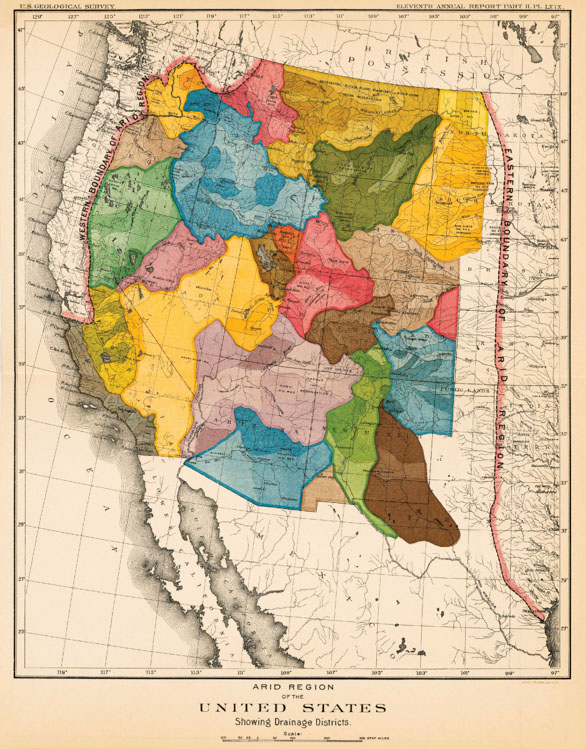 |
| A U.S. Geological Survey map of the 1890s reflects scientist John Wesley Powell's concerns about the agricultural viability of western lands. |
“When I see anybody trying to fix it, I’m rooting for them,” he says, “but I’m also pitying them because most of the government programs have actually encouraged the plowing of the prairie and other bad practices.”
O’Brien sees some neighbors practicing good management, but he says that’s not the norm. “Too often guys are running their cattle the same way and in the same places where their grandfathers ran the cattle, and generally that’s been destructive.”
Jefferson’s plow also remains a threat, he says. “These grasses are our rain forest. Their roots can go 10 feet deep. Our long-stemmed native grasses store as much carbon as the rain forest. They’ve been packing carbon in our soil forever. Every time we plow one of these up and put in a corn field or a golf course or a trailer park, that disappears forever.”
*****
WEST RIVER ranchers might avoid the “D” word, but not Mark Sweeney, who lives in Vermillion — a college town surrounded by flat, lush fields of corn, soybeans and alfalfa.
Sweeney is a professor of sustainability and environment at the University of South Dakota. A native of Phoenix, Arizona, he has researched and studied arid landscapes. Much of his field research has been in the southwestern United States, where sand dunes and the saguaro cactus leave little doubt about the ecosystem. However, Sweeney is also well-acquainted with West River country, and he is well versed on John Wesley Powell’s 19th century assertion that the 100th meridian is a dividing line.
“Powell was quite a character,” he says. “He was a one-armed Civil War veteran who was also a geologist. He led some of the first expeditions through the American West, including the Grand Canyon. The notion of him canoeing down the rapids with one arm is pretty amazing.”
Powell’s climate stance took courage in the 1890s, and it even cost him his position as director of the U.S. Geological Survey. However, Sweeney says time has proved Powell to be right. In fact, just 25 years after Powell’s death, the western plains were decimated by drought.
Sweeney recently mentored a student from Baylor University, Taylor Weeden, who documented over 700 dust storms that hit South Dakota in the 1930s. “One of the leading reasons it was so dusty probably had to do with the percentage of cultivated land at the time. Taylor found that between 50 and 70 percent of the land was in cultivation in East River, and if you go West River, it was less than 20 percent except in Tripp County, where it was closer to 40.”
Like the West River ranchers, Sweeney still stops short of the “D” word. “Semi-arid is probably a better descriptor of that region today,” he says. “Not quite desert, because it still has grasses and other vegetation that have adapted to the climate. The grasses that grow there are critical to binding the soil. If they were not there, you’d be generating dust storms and there would be barren soil farther than the eye can see.”
Actually, says Sweeney, “there’s evidence of that in the past. If you go back to the last Ice Age, maybe 17,000 years ago, there were glaciers east of the Missouri River but west of the river there was no glacial ice and big areas were wind eroded.”
Sweeney says the resulting geographic depressions are still visible in western South Dakota, subtle reminders of the ancient desert. “The troughs are all aligned with the ancient prevailing winds,” he says. “Some streams that occupy these troughs today took advantage of the topography created by the wind.”
Researchers have found evidence of other long periods of mega drought, one as recently as 1,000 years ago that caused some of the dune crests in the Sandhills to reactivate. The Sandhills are considered a Nebraska ecosystem, but they begin on the south edge of Bennett and Todd counties in South Dakota.
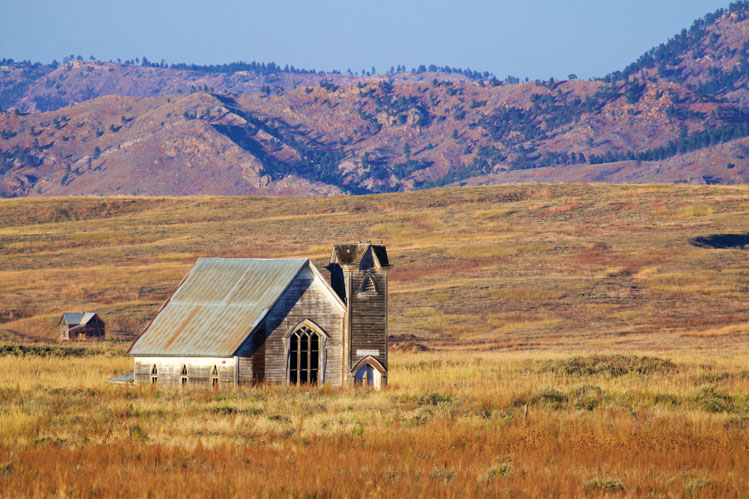 |
| An abandoned church southeast of Edgemont by Hat Creek is a relic of when the West River prairie had many more farmers and ranchers. |
The Vermillion professor says that, without the grass cover, the soil makeup of the West River prairie is quite vulnerable to wind erosion. “You find Pierre shale west of the Missouri River, and when it gets dry and exposed it breaks down into tiny aggregates, little mud balls, that dance about and generate dust as they break away in the wind. It’s like a sandblasting of the prairie.”
*****
SURE ENOUGH, IF YOU drive east of Pierre on Highway 14, you’ll find an historical marker at the 100th meridian, just west of Blunt where Ed Goss said it would be.
Erected in 1956, the marker notes that lending agencies would not, “lend a shiny dime west of this line because some geographer had labeled it the EAST EDGE of the Great American Desert. Today, more than a quarter of America’s new animal wealth alone is produced from that misnamed desert.”
The marker seems to be a 20th century rebuke of Long, Powell and other 19th century explorers and scientists who dared to use the “D” word. Yes, they slightly underestimated the average rainfall, and they underappreciated the tenacity of the native grasses. They also couldn’t know how ranchers like Dave Ollila, Dan O’Brien and others might treat the land.
However, it once was a great American desert. Will it be a desert again?
Sweeney and other modern-day scientists say that depends on climate, as well as on how landowners and public policymakers treat the native grasses. The answer to the future of the arid plains, as the poets say, is blowing in the wind.
Editor’s Note: This story is revised from the July/August 2022 issue of South Dakota Magazine. To order a copy or to subscribe, call (800) 456-5117.


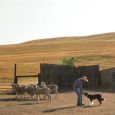


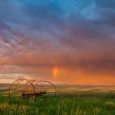
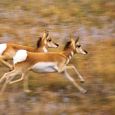
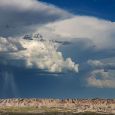


Comments